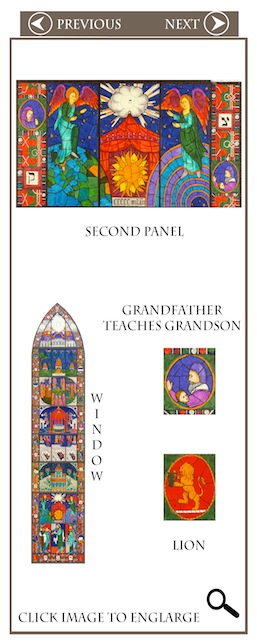
Raphael Loewe: 1 | 2 | 3 | 4 | 5 | 6 | 7 | 8 | 9 | 10 | 11 | 12 | 13 | 14 | 15 |
Object 15. Seven Heavens
Description:
Professor Loewe’s translation of the Seven Heavens poem by Isaac b. Moses, which is read on the Sabbath preceding New Year. He also worked alongside the artist Michael Hall to design a stained-glass window. The window is a visual interpretation of the poem. The viewer should begin at the second panel from the bottom, go up to the top and finish back down on the bottom panel, as was traditional in medieval stained-glass.
Second panel
The image represents the start of the poem. It shows God creating the Seven Heavens by uttering His name. An angel on the left stands over England, where Loewe was from, and France, the home of the original poet, Isaac b. Moses. In the margins a mother instructs her child and a grandfather his grandson (see right). The original Hebrew poem is shaped as a star; this medieval practise is called carmen figuratum.
The Lion in the bottom row became Raphael’s signature (see right). This sort of heraldic signature, or rebus was common in the medieval period. Loewe (for Levi) means Lion in German and the image of the Lion was used self-referentially in his poems. Louis Loewe, his grandfather and his sister also referred to each other as Lion and Lioness.
‘One generation shall praise thy works to another’
Psalm 154:4 inspires this poem, translation and artistic interpretation.
‘Teach then mine intellect the way to go,
And make me understand thine ordinance’
Credits: Leopold Muller Memorial Library, Raphael Loewe Archive, shelfmark: pending cataloguing

